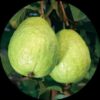- Empty cart.
- Continue Shopping
Guava VNR (Pera)
Original price was: ₹480.00.₹395.00Current price is: ₹395.00.
Genus : Gava
“Experience the bountiful harvest of the VNR Guava Plant. This variety is celebrated for its high yield and nutritious guavas, packed with vitamins and antioxidants. With its robust growth and delectable fruits, you can enjoy the taste of freshness and well-being.”
“VNR” likely refers to a specific variety of guava called the Vietnamese White guava, which is also known as the VNR guava. This variety is believed to have originated in Southeast Asia and is now grown in many tropical and subtropical regions of the world.
Vietnamese White guava trees are small to medium-sized, with a dense canopy of glossy, dark green leaves. The fruits are medium-sized and have a thin, pale green skin that is often blushed with pink. The flesh of the fruit is white, with a sweet, musky flavor and a crunchy texture. The seeds are small and edible.
The Vietnamese White guava is known for its high yield and disease resistance, making it a popular choice for commercial growers. It is typically harvested in the late summer and early fall. In addition to being eaten fresh, Vietnamese White guavas are often used to make juice, smoothies, and other desserts.
Like other guava varieties, Vietnamese White guava plants require warm temperatures, plenty of sunlight, and well-draining soil to produce high-quality fruit. They are generally easy to grow and are tolerant of a wide range of soil types, as long as they are well-draining. Guava plants are often propagated by seed or cuttings and can be grown as a single tree or in a hedge or row. Guava fruits are rich in vitamins and minerals, including vitamin C, vitamin A, and potassium, and are also a good source of dietary fiber and antioxidants.













Reviews
There are no reviews yet.